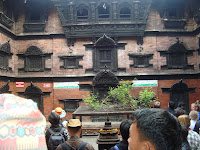The Kumari Devi- The World's Only Living Goddess

Not only does Nepal have many gods, goddess, deities, Bodhisattvas (near Buddhas), avatars and manifestations, which are worshiped and revered as statues, images, paintings and symbols, but it also has a real living goddess. The Kumari Devi is a young girl who lives in the building known as the Kumari Ghar, right beside Kathmandu's Durbar Square . From time immemorial the practice of worshipping an ordinary pre-pubescent girl as a source of supreme power has been an integral part of both Hinduism and Buddhism , a tradition which continues even to this day virtually in every household. They call this girl Kumari Devi and worship her on all the religious occasions. Unlike Hinduism, We Christians believe in a monotheistic God with three persona- Father, Son and the Holy Spirit- the Holy Trinity . Like an egg which has a yolk, the white albumin and the shell. The yolk is still an egg and so is the shell. But each of them is different. Before everything was created, God cannot exist...

